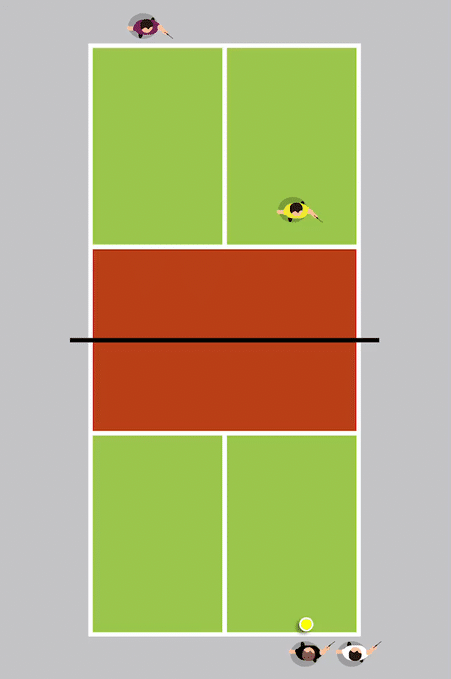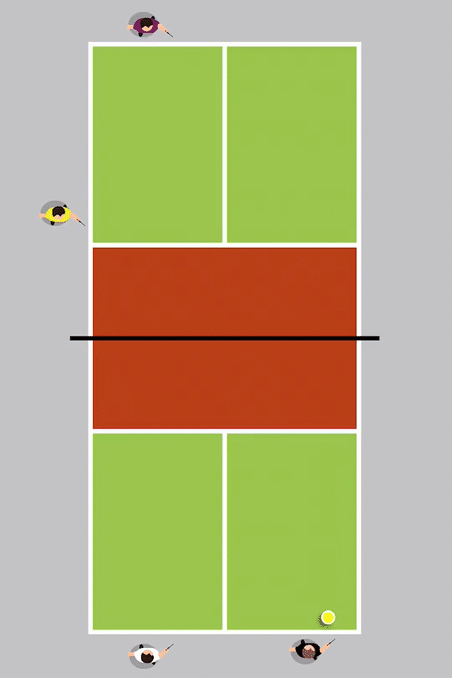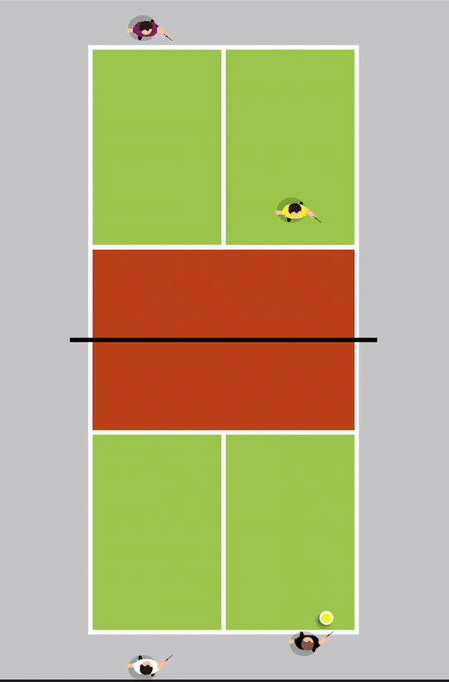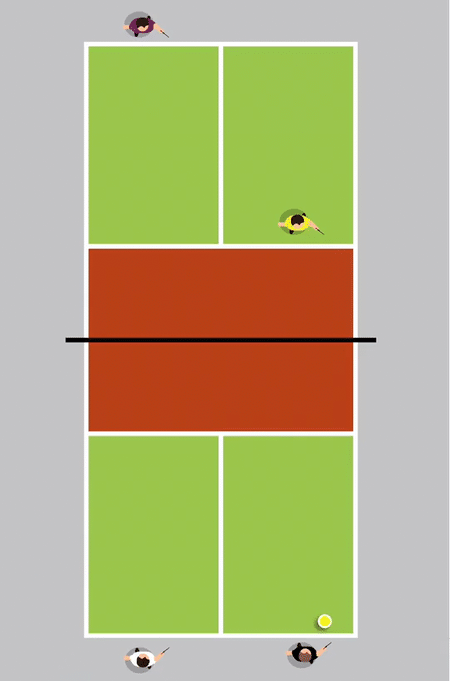One of the more critical elements to playing winning doubles pickleball is being in the ‘right’ place on the court. By ‘right’ here we mean where you are most likely to win points will defending 100% of your court with your partner.
Maybe you have a side of the court that you prefer or you notice that when your partner is directly across from a particular opponent, you win the majority of those points. You ARE paying attention to things like that, right? 😉
If that’s the case, you need to get familiar with ‘stacking’ and ‘switching’ in Pickleball.
Stacking and switching center around getting you and your partner positioned on your strongest side (as the serving team during the serve to be in position for returning your third shot or as the returning team during the return to be in the ideal position for your fourth shot).
We’re going to remove any confusion or mystery around stacking and switching, discuss the differences between them, how to execute each, and the importance of faking (even when you don’t plan on switching)
Stacking Explained
Pickleball stacking refers to the formation in doubles where both players line up on one side of the court during the serve (or return of serve). Once the server hits the ball, each teammate can slide to their preferred side of the court.
If you’re a new player or someone who has just learned the basic pickleball strategies, you may wonder what the point of such a move would be.
The Benefits
As we discussed above, the advantage of stacking is that it gets you and your partner on the strongest side of the court where you are most likely to to win the point. Your individual reasons for determining your strongest side may vary from another team, but some of the more common reasons to utilize stacking are:
- Teams with a righty-lefty combination: These teams typically stack so there are not two backhands in the middle or when one player has a much stronger forehand.
- Player comfort level: one player may feel more comfortable (and have more success) on the odd or even side of the court
- More experienced teams: Use this strategy so one player can be the Blocker and have more opportunities to poach the ball.
- Slower/injured partner: For teams with a member who is less athletically inclined (or injured), stacking permits them to potentially move around the court less.
So rather than maintaining the same side of the court that serving and returning rules may dictate, you can be on the preferred side of the court right after your required serve or return (vs. staying the side that you would ‘traditionally’ occupy opposite your partner. And by stacking, you’re getting on this preferred (and advantageous) side very early in the point to maximize the benefit.
The Disadvantage
The primary disadvantage of stacking (as compared to switching) is you’r removing the element of surprise. When you’re linked up next to the server, your opponents know that the server will slide over to the opposite side of the court and you will be taking the place they previously occupied.
The same is true when the partner is next to the returner. The returner is going to slide over to the opposite court and their partner is going to take their place and occupy side of the court they were both previously on.
You are still gaining the benefit of playing on a preferred side and/or playing across from the desired opponent, and are increasing your odds of winning the point. However, you’re not doing anything to cause confusion with your opponents and so are missing out on an additional benefit that could tip the scales in favor of you and your partner.
Stacking as the Serving Team
To stack as the serving team, the server’s partner will start the point next to the server on the same side of the court.
After the serve, the server will move to the opposite side of the court and their partner will either remain where they are or move over slightly depending on where the server started the point.
At this point right after the serve, the server’s partner will assume the Workhorse role and the server will be the Blocker.
As the serving team, you should expect a down-the-line approach shot return from your opponents.

Stacking as the Returning Team
The returner’s partner will line up off the court near the NVZ on the returner’s side of the court and then move in to once the return has been hit. The returner will move over to the opposite side of the court after hitting their return.
You want to make sure that your return gives you enough time to move over to the opposite side of the court before the third shot from the serving team bounces on your side of the court.
As such, you’ll typically hit a high, ‘loopy’ return vs. a drive or a return with little height because your opponents can return a quick third shot that will likely have you and your partner out of position.
Additionally, the returner will want to hit the return down-the-line to maintain their partner (who is closer to the NVZ) as the Blocker role and they will be the Workhorse.

Switching Explained
Switching is a variation of stacking. Instead of both players starting on one side of the court, each player will start on their ‘traditional’ side and then switch sides of the court after a serve.
The look is identical in every way to a team setup to play the ‘normal’ way of maintaining their positions and working to advance up to the NVZ on the side of the court they started on.
Because it looks the same, it provides some benefit above and beyond what you’re able to achieve as a team utilized stacking as a strategy.
The element of uncertainty that switching creates for your opponents is a reason why you would employ it in a match even though the resulting positions for you and your partner might not necessarily be playing to your strengths.
It’s about sowing indecision in your opponents.
The Benefits
Unlike stacking, switching has the element of surprise. Rather than ‘show your hand’ to your opponents, you’re in the traditional positions to start and then quickly move after the serve.
You have a quick signal with your partner before the point so that you both know if you’re staying or switching.
Another advantage with switching is that even when you’re not executing a switch, you’re executing a ‘fake’. Even if you and your partner decide not to switch, you can keep your opponents guessing by quickly feinting a switch and then moving back to your original positions.
Switching as the Serving Team
Switching requires more activity on the part of the switching team. Before the serve, the server (typically) will let their partner know if they will be switching by saying “I’m going in front” or “Stay” (or something similar).
If you are going to switch, want to relay to your partner if you’re going to go in front of them or behind them as you move to the opposite side of the court (to avoid an embarrassing and maybe painful collision).
A good way to relay the information is to cover your faces with your paddles and, standing close to each other so you can talk at a low volume, let the other know if the switch is on.
When the switch happens, the server will assume the role of Blocker and be alert for any short returns from the opponents.

Switching as the Returning Team
When executing a switching maneuver as the returning team, communication between partners is critical.
The returner’s partner, up at the NVZ, will typically indicate to their partner if the switch is on by using hand signals.
If the returner’s partner shows a closed fist behind their back to the returner, this means that they want to stay (not switch)
If they instead show an open hand, this means that they want to switch.
The returner can verbally say ‘No’ if they don’t agree with their partner’s choice and then the team can fall back to the opposite.
Just as with stacking, a higher, loftier return is ideal if switching to get the returning team is in position and stopped, ready to return the third shot from the serving team.
It’s also critical to think about where the return is going (playing the point out in your head as the returner) so that your return goes in the direction that will maintain your partner as the Blocker role on the court.

Faking the Switch
The uncertainty and possible disruption that comes from your opponents not knowing if you are maintaining your positions on the court can lead to poor shots and unforced errors on their part.
For that reason, if you’re employing a strategy of periodically switching, you should always fake a switch for those time where you’re not actually completing the move to the opposite side of the court.
The movement will have the opponents, who might have committed to going to one partner, changing their mind mid swing resulting in a poor shot or unforced error. Especially if the switching does not follow a pattern where it always happens (or doesn’t happen) in the same players on the same side of the court.
This is especially true for the returning team who has a player already up a the NVZ and in a great position to poach a ball meant for their partner and take time away from the opponents.
Next Steps and Preparing for Your Next Game
There you have it, an introduction to pickleball stacking and pickleball switching to get you and your partner ready for your next pickleball match.
Make sure you practice switching (or stacking) with your partner several times before attempting to do it during a match.
Come up with the triggers that you’ll use, both as the serving team (vocal) and returning team (hand signals) to indicate whether you’ll be switching or not.
Now get out there, practice with your partner(s), and make switching part of your game!
I’m sure you’re going to love the results you see out on the court.
